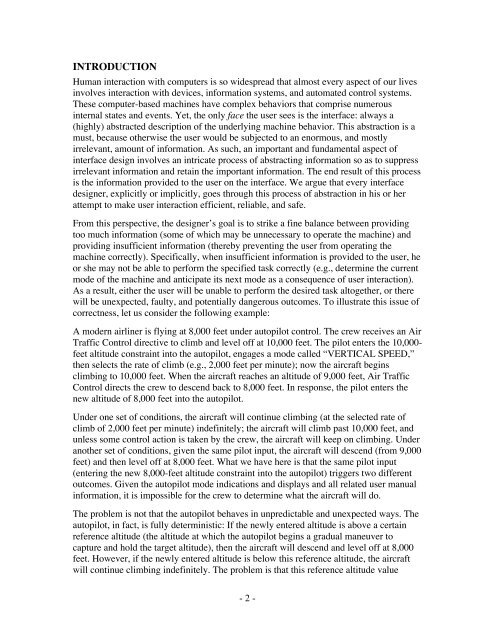formal analysis and automatic generation of user interfaces
formal analysis and automatic generation of user interfaces
formal analysis and automatic generation of user interfaces
You also want an ePaper? Increase the reach of your titles
YUMPU automatically turns print PDFs into web optimized ePapers that Google loves.
INTRODUCTION<br />
Human interaction with computers is so widespread that almost every aspect <strong>of</strong> our lives<br />
involves interaction with devices, information systems, <strong>and</strong> automated control systems.<br />
These computer-based machines have complex behaviors that comprise numerous<br />
internal states <strong>and</strong> events. Yet, the only face the <strong>user</strong> sees is the interface: always a<br />
(highly) abstracted description <strong>of</strong> the underlying machine behavior. This abstraction is a<br />
must, because otherwise the <strong>user</strong> would be subjected to an enormous, <strong>and</strong> mostly<br />
irrelevant, amount <strong>of</strong> information. As such, an important <strong>and</strong> fundamental aspect <strong>of</strong><br />
interface design involves an intricate process <strong>of</strong> abstracting information so as to suppress<br />
irrelevant information <strong>and</strong> retain the important information. The end result <strong>of</strong> this process<br />
is the information provided to the <strong>user</strong> on the interface. We argue that every interface<br />
designer, explicitly or implicitly, goes through this process <strong>of</strong> abstraction in his or her<br />
attempt to make <strong>user</strong> interaction efficient, reliable, <strong>and</strong> safe.<br />
From this perspective, the designer’s goal is to strike a fine balance between providing<br />
too much information (some <strong>of</strong> which may be unnecessary to operate the machine) <strong>and</strong><br />
providing insufficient information (thereby preventing the <strong>user</strong> from operating the<br />
machine correctly). Specifically, when insufficient information is provided to the <strong>user</strong>, he<br />
or she may not be able to perform the specified task correctly (e.g., determine the current<br />
mode <strong>of</strong> the machine <strong>and</strong> anticipate its next mode as a consequence <strong>of</strong> <strong>user</strong> interaction).<br />
As a result, either the <strong>user</strong> will be unable to perform the desired task altogether, or there<br />
will be unexpected, faulty, <strong>and</strong> potentially dangerous outcomes. To illustrate this issue <strong>of</strong><br />
correctness, let us consider the following example:<br />
A modern airliner is flying at 8,000 feet under autopilot control. The crew receives an Air<br />
Traffic Control directive to climb <strong>and</strong> level <strong>of</strong>f at 10,000 feet. The pilot enters the 10,000-<br />
feet altitude constraint into the autopilot, engages a mode called “VERTICAL SPEED,”<br />
then selects the rate <strong>of</strong> climb (e.g., 2,000 feet per minute); now the aircraft begins<br />
climbing to 10,000 feet. When the aircraft reaches an altitude <strong>of</strong> 9,000 feet, Air Traffic<br />
Control directs the crew to descend back to 8,000 feet. In response, the pilot enters the<br />
new altitude <strong>of</strong> 8,000 feet into the autopilot.<br />
Under one set <strong>of</strong> conditions, the aircraft will continue climbing (at the selected rate <strong>of</strong><br />
climb <strong>of</strong> 2,000 feet per minute) indefinitely; the aircraft will climb past 10,000 feet, <strong>and</strong><br />
unless some control action is taken by the crew, the aircraft will keep on climbing. Under<br />
another set <strong>of</strong> conditions, given the same pilot input, the aircraft will descend (from 9,000<br />
feet) <strong>and</strong> then level <strong>of</strong>f at 8,000 feet. What we have here is that the same pilot input<br />
(entering the new 8,000-feet altitude constraint into the autopilot) triggers two different<br />
outcomes. Given the autopilot mode indications <strong>and</strong> displays <strong>and</strong> all related <strong>user</strong> manual<br />
information, it is impossible for the crew to determine what the aircraft will do.<br />
The problem is not that the autopilot behaves in unpredictable <strong>and</strong> unexpected ways. The<br />
autopilot, in fact, is fully deterministic: If the newly entered altitude is above a certain<br />
reference altitude (the altitude at which the autopilot begins a gradual maneuver to<br />
capture <strong>and</strong> hold the target altitude), then the aircraft will descend <strong>and</strong> level <strong>of</strong>f at 8,000<br />
feet. However, if the newly entered altitude is below this reference altitude, the aircraft<br />
will continue climbing indefinitely. The problem is that this reference altitude value<br />
- 2 -

















